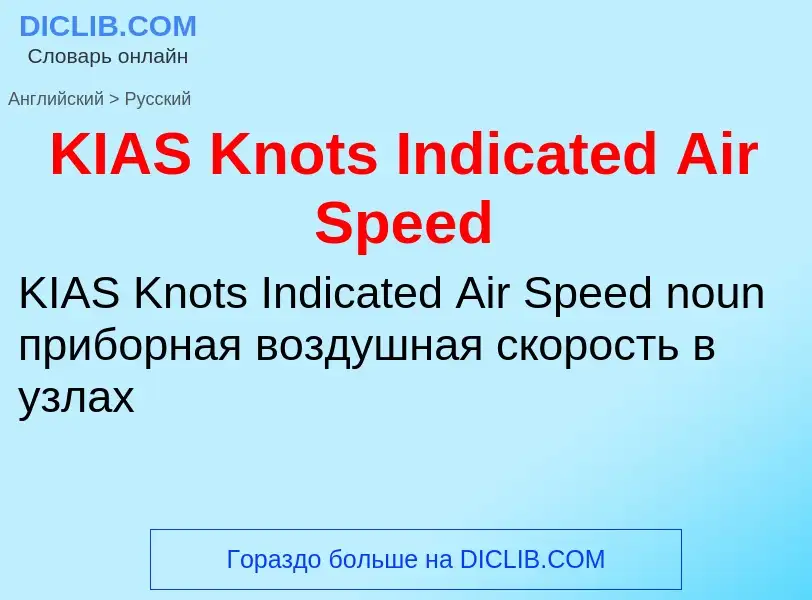Tradução e análise de palavras por inteligência artificial ChatGPT
Nesta página você pode obter uma análise detalhada de uma palavra ou frase, produzida usando a melhor tecnologia de inteligência artificial até o momento:
- como a palavra é usada
- frequência de uso
- é usado com mais frequência na fala oral ou escrita
- opções de tradução de palavras
- exemplos de uso (várias frases com tradução)
- etimologia
KIAS Knots Indicated Air Speed - tradução para Inglês
['spi:dlimit]
существительное
общая лексика
дозволенная скорость
предельная скорость (езды)
техника
предел скорости
предел числа оборотов
['spi:diŋ]
существительное
общая лексика
езда на большой скорости
езда с недозволенной скоростью
Wikipédia
Indicated airspeed (IAS) is the airspeed of an aircraft as measured by its pitot-static system and displayed by the airspeed indicator (ASI). This is the pilots' primary airspeed reference.
This value is not corrected for installation error, instrument error, or the actual encountered air density, being instead calibrated to always reflect the adiabatic compressible flow of the International Standard Atmosphere at sea level.
It uses the difference between total pressure and static pressure, provided by the system, to either mechanically or electronically measure dynamic pressure. The dynamic pressure includes terms for both density and airspeed. Since the airspeed indicator cannot know the density, it is by design calibrated to assume the sea level standard atmospheric density when calculating airspeed. Since the actual density will vary considerably from this assumed value as the aircraft changes altitude, IAS varies considerably from true airspeed (TAS), the relative velocity between the aircraft and the surrounding air mass. Calibrated airspeed (CAS) is the IAS corrected for instrument and position error.
An aircraft's indicated airspeed in knots is typically abbreviated KIAS for "Knots-Indicated Air Speed" (vs. KCAS for calibrated airspeed and KTAS for true airspeed).
The IAS is an important value for the pilot because it is the indicated speeds which are specified in the aircraft flight manual for such important performance values as the stall speed. These speeds, in true airspeed terms, vary considerably depending upon density altitude. However, at typical civilian operating speeds, the aircraft's aerodynamic structure responds to dynamic pressure alone, and the aircraft will perform the same when at the same dynamic pressure. Since it is this same dynamic pressure that drives the airspeed indicator, an aircraft will always, for example, stall at the published indicated airspeed (for the current configuration) regardless of density, altitude or true airspeed.
Furthermore, the IAS is specified in some regulations, and by air traffic control when directing pilots, since the airspeed indicator displays that speed (by definition) and it is the pilot's primary airspeed reference when operating below transonic or supersonic speeds.


![Historic [[New Hampshire]] speed limit sign Historic [[New Hampshire]] speed limit sign](https://commons.wikimedia.org/wiki/Special:FilePath/Antique New Hampshire speed limit sign.jpg?width=200)


![[[Gatso]] speed camera [[Gatso]] speed camera](https://commons.wikimedia.org/wiki/Special:FilePath/Gatso Camera.jpg?width=200)

![[[Traffic calming]] can be effective on lower speed roads. [[Traffic calming]] can be effective on lower speed roads.](https://commons.wikimedia.org/wiki/Special:FilePath/One-lane chicane 1.jpg?width=200)
![The [[Pan-American Highway]] with central median and no freestanding obstructions increasing the level of safety at high speed The [[Pan-American Highway]] with central median and no freestanding obstructions increasing the level of safety at high speed](https://commons.wikimedia.org/wiki/Special:FilePath/Ruta Panamericana Buenos Aires Florida.jpg?width=200)



![Indonesia (in km/h) includes the text "km" on the top right corner; this model was also used by a number of European countries such as Germany, Italy and [https://commons.wikimedia.org/wiki/File:MFG_Signale_S.4.jpg Switzerland] until the 1960s. Indonesia (in km/h) includes the text "km" on the top right corner; this model was also used by a number of European countries such as Germany, Italy and [https://commons.wikimedia.org/wiki/File:MFG_Signale_S.4.jpg Switzerland] until the 1960s.](https://commons.wikimedia.org/wiki/Special:FilePath/Indonesia New Road Sign Pro 4h.png?width=200)
![[[Indonesia]] (includes the text "km" on the top right corner); km/h [[Indonesia]] (includes the text "km" on the top right corner); km/h](https://commons.wikimedia.org/wiki/Special:FilePath/Indonesia New Road Sign Mndtry 44.png?width=200)
